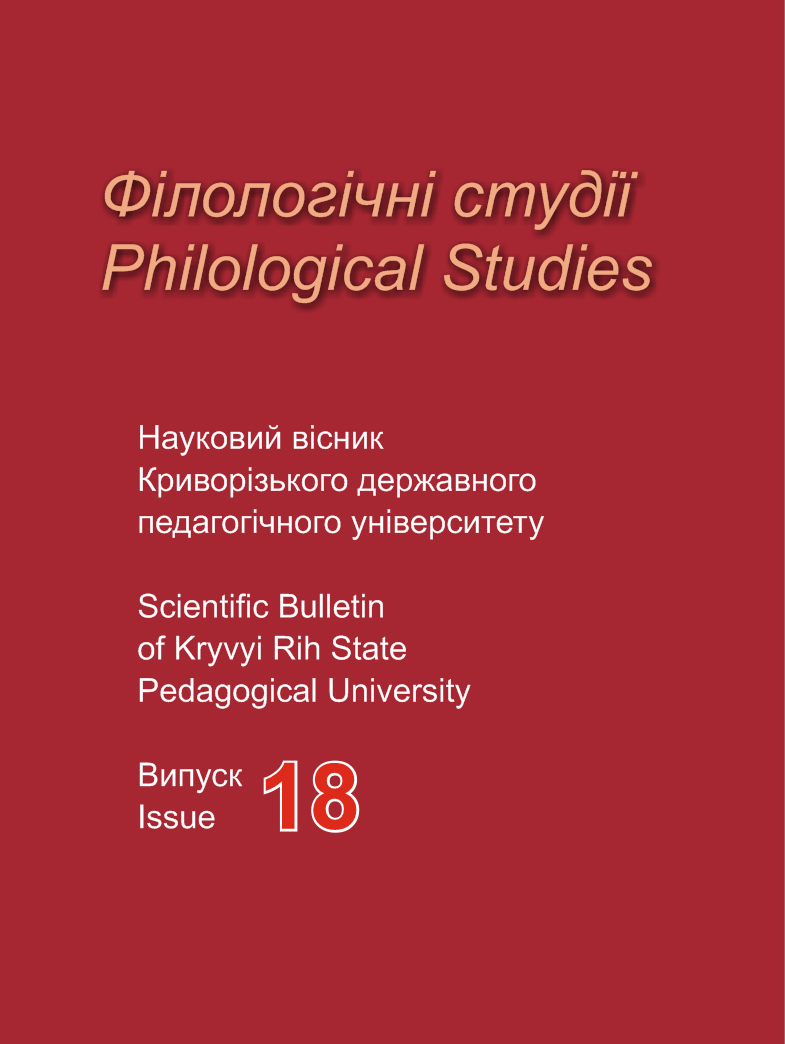Correlation of concepts of “apposition” and “predicate” in linguistic science
DOI:
https://doi.org/10.31812/filstd.v18i0.2128Keywords:
separated apposition (noun phrase), compound nominal predicate, semi-predicativity, temporality, modalityAbstract
The article deals with the analysis of scientific works, in which researchers investigate the problem of correlation between the concepts of apposition and predicate. O. Potebnia thought that the relative independence is at the heart of the concept of apposition. It is necessary to regard the relative independence as a greater predicativity of an apposition compared to a proper attribute. O. Shakhmatov defined the grammatical essence of an apposition as of a member of the sentence which occupies the intermediate position between the attribute and the compound nominal predicate. M. Hrech and F. Buslaiev defined the semantics of appositive members of a sentence which are expressed by a noun, a participle and an adverbial participle as a reduced predicativity. Most linguists traditionally asserted that the feature of some predicativity (additional shades of adverbial modifiers) is typical only of a separated apposition (B. Kulyk, O. Melnychuk, D. Ovsianyko-Kulykovskyi, etc.). An apposition should not be identified with an inseparable apposition. We can not transform an apposition into an inseparable apposition. If such transformation is possible, the apposition will be different in the semantic connections with the noun it modifies. The research reflects the modern understanding of apposition as a semi-predicative member of a sentence in which the prevailing grammar of attributive relations is combined with the one of predicative relations (I. Aribzhanova, A. Moisiienko, etc.). Semi-predicativity is a syntactic significance which partly coincides with the predicative one but does not form an independent syntactic unit. Noun phrases do not have syntactic means of expression of temporality and modality. Their tense and modality coincide with the tense and the modality of the main predicate. Only sometimes the temporal significance of a noun phrase can be emphasized lexically – by means of the words with temporal semantics. The synthesis of the attributive and predicative features allows to transform an apposition into a compound nominal predicate. The semi-predicative attributive function of a noun phrase correlates with its predicative function in the case of transformation of the sentence with the apposition into a complex attributive sentence or two complete simple sentences. At the same time, a noun phrase can be only transformed into a subordinate attributive clause of the most elementary form, which includes a predicate in the past or present tense and the indicative mood. Subordinate clauses with future tense and subjunctive or imperative moods are not correlated with noun phrases because the latter can not express such modal-tense details.
Metrics
References
Арібжанова І. М. Уточнення і прикладка в сучасній українській мові. Мовні і концептуальні картини світу. 2011. Вип.36. С.46–52. URL: http://www.philology.kiev.ua/library/zagal/Movni_i_konceptualni _2011_36/046_052.pdf (дата звернення: 12.01.2018).
Буслаев Ф. И. Историческая грамматика русского языка. Москва, 1881.Ч.2: Синтаксис. 394с. URL: http://elib.shpl.ru/ru/nodes/35996-ch-2-sintaksis-1881#page/1/mode/grid/zoom/1 (дата обращения: 03.02.2018).
Вихованець І. Р. Прикладка. Українська мова: Енциклопедія. Київ: Вид-во “Українська енциклопедія” імені М. П. Бажана, 2004. С.524–525.
Горголюк Н. Г. Особливості функціонування категорії прикладки в логіко-семантичному аспекті. Наукові праці Кам’янець-Подільського національного університету імені І. Огієнка. Філологічні науки. Кам’янець-Подільський, 2009. Вип.20. С.123–126. URL: http://nbuv.gov.ua/UJRN/Npkpnu_fil_2009_20_36 (дата звернення: 15.02.2018).
Греч Н. И. Практическая русская грамматика. Санктпетербургъ, 1827. 578с. URL: http://imwerden.de/pdf/grech_prakticheskaya_russkaya_grammatika_1827.pdf(дата обращения: 04.01.2018).
Кулик Б. М. Курс сучасної української літературної мови. Синтаксис. Київ: Радянська школа, 1961. 286с.
Кульбабська О. В. Вторинна предикація у простому реченні: монографія. Чернівці: Чернівецький національний університет, 2011. 672с.
Кульбабська О. В. Напівпредикативні конструкції як засіб компресії (“згущення думки”). Науковий часопис Національного педагогічного університету імені М. П. Драгоманова. Серія10: Проблеми граматики і лексикології української мови. 2011. Вип.7. С.191–195. URL: http://nbuv.gov.ua/UJRN/Nchnpu_10_2011_7_44(дата звернення: 05.02.2018).
Курс сучасної української літературної мови: Синтаксис/ за ред. Л. А. Булаховського. Київ, 1951. Т.2. 407с.
Овсянико-Куликовский Д. Н. Синтаксис русского языка. Санкт-Петербург, 1912. XXXV. 322с. URL: http://e-heritage.ru/ras/view/ publication/general.html?Id=48367378 (дата обращения: 26.12.2017).
Плющ М. Я. Словоформа в семантично елементарному та ускладненому реченні: вибрані праці. Київ: Видавництво Національного педагогічного університету імені М. П. Драгоманова, 2011. 362с.
Потебня А. А. Из записок по русской грамматике. Москва, 1958. Т.1–2. 354с. URL: http://elib.gnpbu.ru/text/potebnya_iz-zapisok-po-russkoy-grammatike_t1-2_1958/go,536;fs,1/ (дата обращения: 17.12.2017).
Слинько І. І., Гуйванюк Н. В., Кобилянська М. Ф. Синтаксис сучасної української мови: проблемні питання: навч. посіб. Київ: Вища школа, 1994. 670с.
Сучасна українська мова: Синтаксис: підручник / А. К. Мойсієнко, І. М. Арібжанова, В. В. Коломийцева та ін.; за ред. А. К. Мойсієнка. Київ: Знання, 2013. 238с.
Шахматов А. А. Синтаксис русского языка.Москва: Эдиториал УРСС, 2001. 624с. URL: https://www.twirpx.com/file/761436/ (дата обращения: 21.12.2017).






